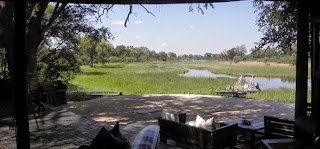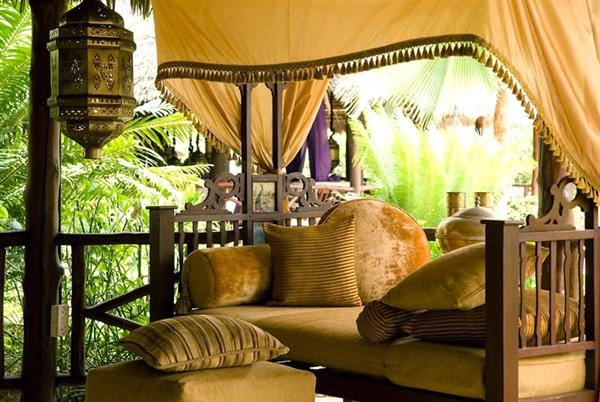Scheduled Private Guided Safari - 'Into The Wild' led by Peter and Soren Lindstrom - Zambia July 2015
Our association with the brothers Peter and Soren Lindstrom, living at opposite sides of Africa, goes back 25 years. Soren is a legendary safari guide in Southern Africa, Peter the best in his home country, Tanzania. Our guests, usually in private parties of friends or family, have been going on safari with either Peter or Soren for decades.
A privately guided safari is often prohibitively expensive for a singleton or couple. Now Bushbuck Safaris has introduced scheduled privately guided safaris which singletons and couples can book into, joining a small group. Soren and Peter welcomed the idea of guiding together and leading our scheduled safaris. Our first safari was in February - The Great Migration Safari in Tanzania. One guest commented that they were not sure who enjoyed the safari most - the guests or the guides - they all had a great time together and another guest wrote "I cannot say enough on behalf of Peter and Soren in germs of exposing us to all manners of wildlife, birds and even insects and explaining how they relate to eachother and the environment. We had a thoroughly fascinating trip..and enjoyed ourselves enormously".
Following on from this success, we have arranged a return match - this time Peter joins Soren in Southern Africa, leading our Into the Wild Safari to Zambia in July 2015. The itinerary is a combination of what we know to be the two best remote wildlife areas and camps of Zambia, ending with a few nights at Victoria Falls and with an optional extension into Botswana. There are just eight places on this unique scheduled privately guided safari. There will come a time when safaris with this calibre of guiding are a thing of the past, please don't miss out and book in soon.
Detailed itinerary on request from info@bushbucksafaris.com, outlined itinerary as follows;
INTO THE WILD + THE LINDSTROM BROTHERS - ZAMBIA JULY 2015
Sunday 19 July - Arrival Lusaka Airport, Zambia
On arrival Lusaka Airport, welcomed by Soren and Peter Lindstrom, driven to the small exclusive Latitude 15 hotel in Lusaka. Remainder of the day at leisure or time for some shopping.
Monday 20 July - Fly to South Luangwa National Park, 4 nights at Lion Camp
Fly from Lusaka to Mfuwe for your 4 night stay at one of our favourite camps in Africa - Lion Camp, located in the remote northern sector of the South Luangwa National Park, with incredible gameviewing, elephant wandering through camp, lots of predators, one of the best places in Africa to view leopard, and here walking safaris are an option to gamedrives. Fabulous chalet accommodation raised on stilts with wooden walkways, great camp staff and excellent cuisine. From your verandah you look out directly onto a wilderness area and wildlife.
Friday 24 July - Fly to Northern Kafue National Park and the wilderness area of the Busanga Plains, 3 nights at Busanga Plains Camp
Only accessible from July to October the Busanga Plains is one of Africa's wildest wildlife regions, truely remote for a real Africa safari experience. Walking is also an option here to gamedrives.
Monday 27 July - Fly to Livingstone for Victoria Falls, 2 nights at Victoria Falls Safari Lodge
Fly to Livingstone, and driven to Victoria Falls for your 2 night stay at the wonderful Victoria Falls Safari Lodge on the Zimbabwean side of the Falls, the best side for viewing The Falls at this time of year, and one of our favourite lodges in the region.
Wednesday 29 July - International departure from Victoria Falls
International departure from Victoria Falls, via Johannesburg and home from there, (alternatively continue your safari into Botswana for the 4 night optional extension, as detailed below).
Safari Price:
US$10,800 per person with maximum of 8 participants
US$11,450 per person with 7 participants
US$12,250 per person with 6 participants
US$13,400 per person with 5 participants
Single Supplement: US$1300
Inclusions: Services of professional wildlife guides Soren and Peter Lindstrom, private charters Mfuwe/Busanga and Busanga/Livingstone for Victoria Falls, scheduled flight Lusaka/Mfuwe, all accommodation (including exclusive use of both camps for a party of 8), all meals, all gameviewing, all drinks in camps, all road transfers, all conservation, park and reserve fees, tour of Victoria Falls and dinner cruise on the Zambezi, laundry in camps and flying doctor insurance.
Exclusions: International flights to Lusaka and from Victoria Falls (via Johannesburg is usually best routing) and airport departure taxes, travel insurance, visa fees, bar bill at Victoria Falls Safari Lodge, champagne, cellar wines, premium brand spirits throughout, tipping and items of a private or personal nature.
OPTIONAL 4 NIGHT EXTENSION TO BOTSWANA
Wednesday 29 July - Houseboat, Chobe River, Botswana
Driven by Soren Lindstrom across the border into Botswana to join the Zambezi Voyager Houseboat for a relaxing lunch, afternoon and night cruising the Chobe and Zambezi Rivers, watching wildlife on the riverbanks.
Thursday 30 July - fly to the Okavango Delta, 3 nights at Shinde Camp
Fly to Shinde Camp located in the heart of the famous Okavango Delta, in a scenery of islands, palms, woodland, open plains, channels of water, open lagoons so characteristic of the unique Okavango Delta. Enjoy four days here with varied activities - gamedrives and walking safaris on the open plains or canoeing and boating the waterways.
Sunday 02 August - International departure
Fly to Maun and from Maun there are daily connections to Johannesburg for onward travel home.
Price of 4 night Extension to Botswana:
From $4355 per person in a party of eight to $5155 per person in a party of two.
Inclusions: Services of Professional guide Soren Lindstrom, scheduled flights from Kasane to Shinde and Shinde to Maun, all accommodation, all meals, all drinks, all gameviewing, all conservation, reserve and park fees, flying doctor insurance.
Exclusions: International flights and departure taxes, travel insurance, champagne, cellar wines and premium brand spirits, tipping and items of a private or personal nature.

















































